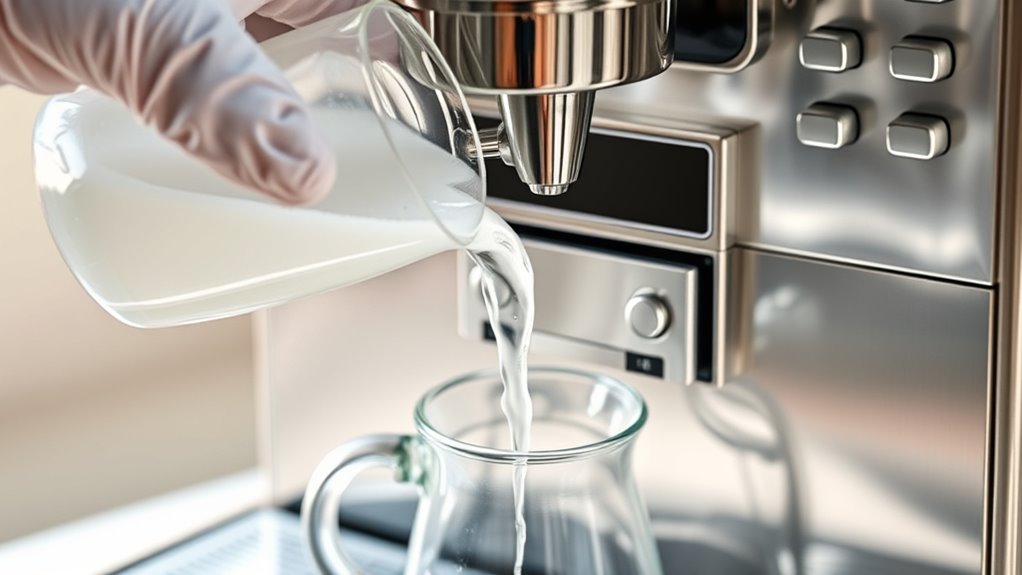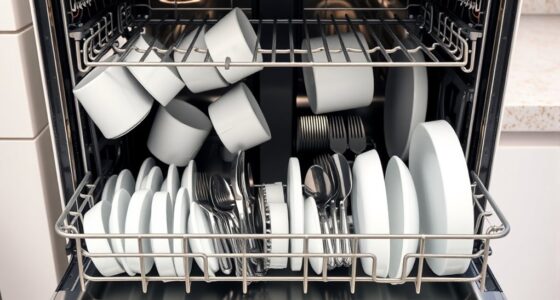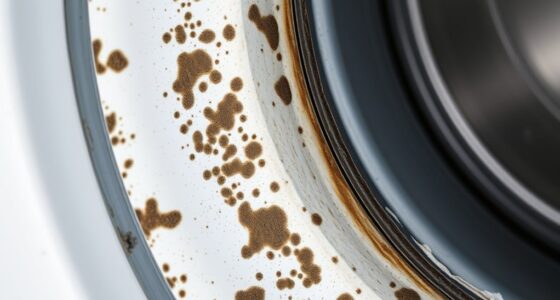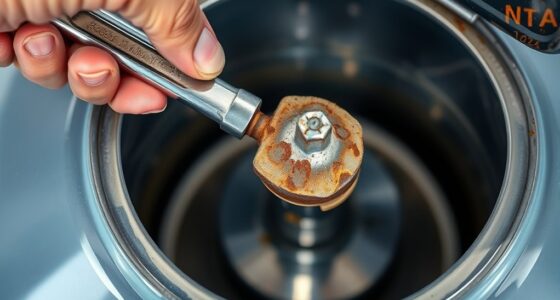To descale your coffee maker or espresso machine, start by unplugging it and emptying any leftover water. Fill the reservoir with a mixture of equal parts water and white vinegar or use a commercial descaling solution. Run a brew cycle without coffee grounds to circulate the solution, then let it sit for 15-20 minutes. Finish by running several rinse cycles with clean water. Proper maintenance helps keep your machine running smoothly—continue exploring to learn more!
Key Takeaways
- Unplug the machine, empty water, and fill the reservoir with a descaling solution or vinegar-water mixture.
- Run a brew cycle without coffee to circulate the descaling solution through internal components.
- Let the solution sit for 15-20 minutes to loosen mineral buildup.
- Follow with at least two rinse cycles using plain, filtered water to remove residual descaling agents.
- Clean removable parts and exterior with warm, soapy water to maintain overall hygiene and performance.

Over time, mineral deposits from hard water can build up inside your coffee maker, affecting the taste and performance. These deposits can clog the internal components, leading to a decline in brew strength and uneven extraction. When mineral buildup occurs, your coffee might taste dull or bitter, and the machine may need more time to brew a cup. Regular descaling is essential to keep your coffee maker functioning at its best and to maintain the quality of your brew. One effective way to prevent excessive mineral deposits is to guarantee your water filtration system is working properly. Using filtered water reduces the amount of minerals entering your machine, slowing down the buildup process and preserving the integrity of your coffee’s flavor.
Before you start descaling, unplug your coffee maker and empty any remaining water. Fill the water reservoir with a descaling solution, which you can buy commercially or make yourself with equal parts of water and white vinegar. Vinegar is a natural descaler that’s safe and cost-effective, but commercial descaling products often contain stronger agents that can be more effective for stubborn buildup. Once filled, turn on the machine and run a brew cycle without coffee grounds. This process helps the descaling solution circulate through the internal components, breaking down mineral deposits. If your machine has a brew strength setting, opt for the highest setting to ensure maximum contact of the solution with all internal surfaces, especially those prone to buildup. Proper maintenance can significantly extend the lifespan of your coffee maker and improve the quality of your brew.
After completing the cycle, let the solution sit in the machine for about 15-20 minutes to loosen any remaining deposits. Then, run at least two full cycles with plain, filtered water to thoroughly rinse out the vinegar or descaling solution. Proper water filtration plays a critical role here, as it minimizes the minerals that can cause future buildup, extending the time between descales. Be sure to clean removable parts like filters, drip trays, and water reservoirs with warm, soapy water to remove any residual deposits or grime. Wiping down the exterior and cleaning the brew basket helps keep your machine in top shape and prevents mold or bacteria growth. Regular descaling, combined with using good water filtration, keeps your coffee machine running smoothly and your coffee tasting fresh. Frequency depends on your water quality and usage, but generally, descaling every 1-3 months is advisable. By maintaining your machine, you’ll enjoy consistently strong, flavorful brews and prolong the lifespan of your appliance. Proper care ensures your coffee maker remains a reliable part of your daily routine, delivering the perfect cup every time.
Frequently Asked Questions
How Often Should I Descale My Coffee Machine?
You should descale your coffee machine every 1 to 3 months, depending on water hardness and coffee residue buildup. If you use hard water, descale more frequently to prevent mineral deposits. Regular descaling helps maintain ideal taste and prevents clogs. Keep an eye on your machine’s performance and taste; if coffee starts tasting off or brewing slows, it’s time to descale, even if it’s been less than three months.
Can I Use Vinegar Instead of Commercial Descaling Products?
They say “a penny saved is a penny earned,” but using vinegar instead of commercial descaling products isn’t always the best idea. Vinegar alternatives can work, but they might not be as effective or safe for your machine. Commercial products often have benefits like better corrosion control and thorough cleaning. If you choose vinegar, dilute it properly and rinse thoroughly to avoid lingering taste or damage.
What Are Signs My Machine Needs Descaling?
You’ll notice scale buildup on your machine’s internal parts or a decrease in water flow, which signals you need to descale. If your water is hard, scale forms faster, making these signs more noticeable. You might also see your coffee or espresso tasting off or taking longer to brew. Regularly checking for these signs helps prevent damage caused by mineral deposits from water hardness.
Is Descaling Necessary for All Coffee Makers?
A stitch in time saves nine, so you should descale your coffee maker regularly. Not all types of coffee machines need descaling equally; for example, espresso machines and drip brewers benefit from routine cleaning. Using the right descaling chemicals guarantees longevity and flavor. If you notice mineral build-up or off-tastes, it’s time to descale—keeping your machine in top shape prevents costly repairs and maintains great coffee quality.
How Do I Prevent Mineral Buildup in My Machine?
You can prevent mineral buildup by using filtered or soft water, which reduces water hardness and minimizes mineral deposits. Regularly cleaning your machine and running a water cycle with vinegar helps prevent accumulation. Keep an eye on water quality, and avoid using hard tap water if possible. These steps help maintain your machine’s performance and extend its lifespan by reducing mineral deposits and buildup.
Conclusion
Now that you know how to descale your coffee maker or espresso machine, you’re taking control of every sip. Regular descaling keeps your machine humming like a well-tuned orchestra, ensuring each cup tastes just as wonderful as the first. Think of it as giving your beloved coffee a spa day—refreshing, revitalizing, and worth every moment. Stay vigilant with this simple routine, and let your mornings be filled with the rich aroma of perfectly brewed coffee.









